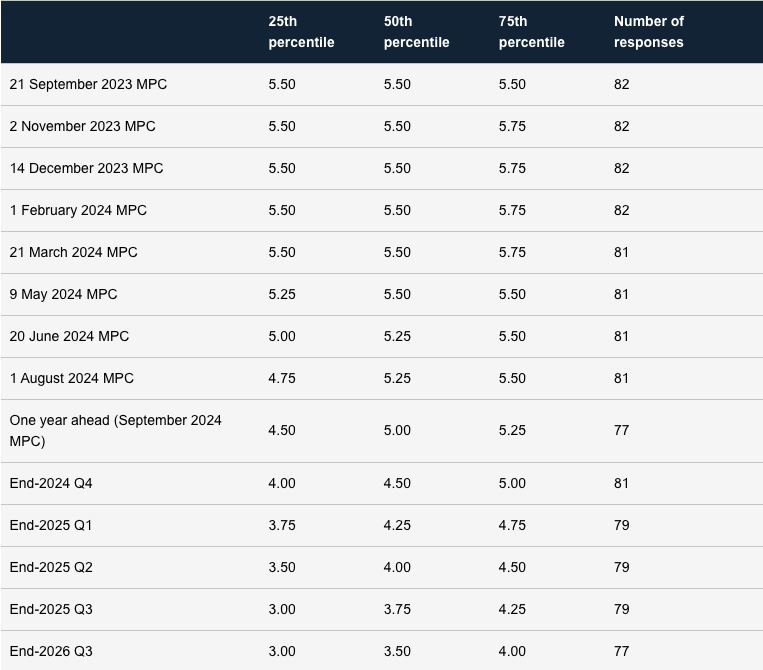Bank of England Survey: Market Expectations & Macroeconomic

Establishing the Topic:
In today’s rapidly changing world, it is crucial for policymakers and market participants to have a deep understanding of market expectations and macroeconomic factors. This knowledge allows for informed decision-making and ensures the stability and growth of the economy. The Bank of England, recognizing the importance of market intelligence, conducts surveys to gather insights into market expectations for various economic indicators. These surveys provide valuable information that enhances policymakers’ understanding of market sentiment and helps shape monetary policy.
Breakdown of Key Concepts:
One such survey conducted by the Bank of England focuses on market expectations for Bank Rate. The survey, formulated by Bank of England staff, involves selected market participant firms with expertise in UK rates markets and monetary policy. It includes questions about the most likely level of Bank Rate after different Monetary Policy Committee (MPC) meetings, as well as probabilities of different Bank Rate levels and the peak level of Bank Rate. Respondents are also asked to assign probabilities to rate cuts within specific time frames, and the balance of risks surrounding Bank Rate expectations is assessed. This comprehensive survey provides policymakers with a range of perspectives on future interest rate movements.
Another aspect covered in the survey is the macroeconomic outlook. Respondents are asked to provide their expected rates of Consumer Price Index (CPI) inflation at different time horizons. This information helps policymakers gauge inflation expectations and make informed decisions regarding monetary policy. The survey also examines differences in GDP growth projections compared to the MPC’s assessment, providing alternative insights into the state of the economy.
The Bank of England’s survey also delves into the bank’s balance sheet and gilt yields. Respondents are asked about the expected reduction in the stock of purchased gilts after a certain date, providing insights into the bank’s plans for managing its balance sheet. Additionally, respondents provide their expectations for the most likely levels of the 10-year gilt yield at different future points. This information helps market participants and policymakers gauge market sentiment and anticipate future changes in gilt yields.
Lastly, the survey explores market expectations for exchange rates. Respondents provide their predictions for the most likely levels of GBPUSD and EURGBP exchange rates at different future points. This information is valuable for businesses and investors who need to make informed decisions regarding currency risk management.
Discussion of Practical Aspects:
The Bank of England’s survey provides policymakers with a comprehensive view of market sentiment and expectations. By incorporating median, 25th and 75th percentiles, as well as mean probabilities, the survey offers a detailed analysis of market expectations. This information allows policymakers to assess the balance of risks surrounding their decisions. Furthermore, the survey explores a range of factors influencing expectations for Bank Rate, providing a nuanced understanding of market dynamics.
The analysis of CPI inflation rates and probabilities offers insights into inflation expectations at different time horizons. This information helps policymakers gauge the effectiveness of their monetary policy decisions and adjust their strategies accordingly. Additionally, the examination of differences in GDP growth projections provides an alternative perspective to the MPC’s assessment, enriching the overall understanding of the economy’s trajectory.
The exploration of the bank’s balance sheet plans and expected gilt yields contributes to understanding the Bank of England’s future actions. This information helps market participants anticipate changes in the bond market and adjust their investment strategies accordingly. Similarly, market expectations for exchange rates provide valuable insights for businesses and investors who need to plan for currency fluctuations.
Strong Conclusion:
In conclusion, the Bank of England’s surveys play a vital role in enhancing policymakers’ understanding of market expectations and macroeconomic factors. These surveys provide valuable insights into market sentiment, inflation expectations, GDP growth projections, and exchange rate forecasts. By incorporating a range of perspectives from market participant firms, the Bank of England ensures a comprehensive view of the economic landscape. This information allows policymakers to make informed decisions that promote stability and growth. It is imperative for market participants and policymakers alike to pay attention to the insights provided by these surveys, as they offer valuable market intelligence that is essential for navigating the complex world of finance and economics.
Call to Action:
As we move forward, it is crucial for policymakers, market participants, and the wider public to stay informed about market expectations and macroeconomic factors. By being aware of the insights provided by the Bank of England’s surveys, we can better understand the economic landscape and make informed decisions that contribute to the stability and growth of our economy. Let us embrace the valuable market intelligence offered by these surveys and use it to shape a prosperous future for all.
Interested in speaking with our consultants? Click here to get in touch.

